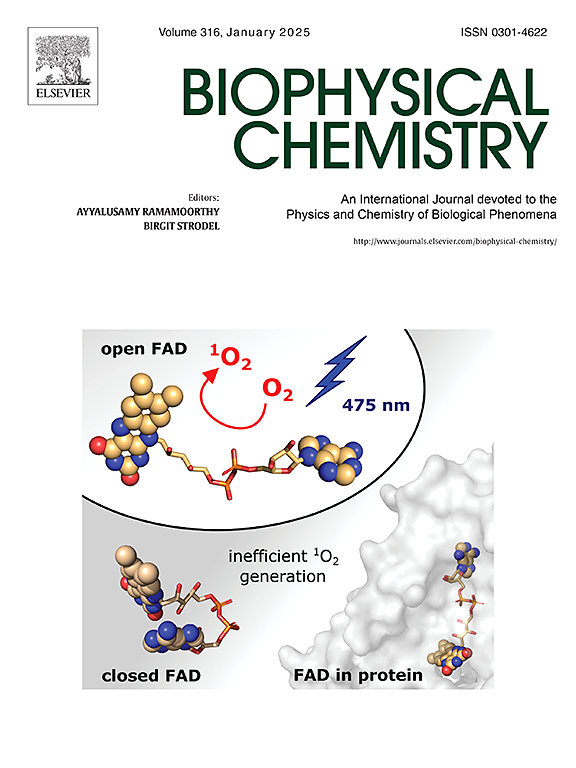Investigation of serotonin-receptor interactions, stability and signal transduction pathways via molecular dynamics simulations
IF 2.2
3区 生物学
Q2 BIOCHEMISTRY & MOLECULAR BIOLOGY
引用次数: 0
Abstract
Serotonin-receptor binding plays a key role in several neurological and biological processes, including mood, sleep, hunger, cognition, learning, and memory. In this article, we performed molecular dynamics simulation to examine the key residues that play an essential role in the binding of serotonin to the G-protein-coupled 5-HT1B receptor (5HT1BR) via electrostatic interactions. Key residues for electrostatic interactions were identified via bond distance analysis and frustration analysis methods. An end-point free energy calculation method determines the stability of the 5-HT1BR due to serotonin binding. The single-point mutation of the polar/charged amino acid residues (Asp129, Thr134) on the binding sites and the calculation of binding free energy validate the quantitative contribution of these residues to the stability of the serotonin-receptor complex. The principal component analysis reflects that the serotonin-bound 5-HT1BR is more stabilized than the apo-receptor regarding dynamical changes. The difference dynamic cross-correlations map shows the correlation between the transmembranes and mini-Go, which indicates that the signal transduction happens between mini-Go and the receptor. Allosteric pathway analysis reveals the key nodes and key pathways for signal transduction in 5-HT1BR. These results provide useful insights into the study of signal transduction pathways and mutagenesis to regulate the binding and functionality of the complex. The developed protocols can be applied to study local non-covalent interactions and long-range allosteric communications in any protein-ligand system for computer-aided drug design.

通过分子动力学模拟研究血清素受体相互作用、稳定性和信号转导途径。
血清素受体结合在几个神经和生物过程中起着关键作用,包括情绪、睡眠、饥饿、认知、学习和记忆。在本文中,我们进行了分子动力学模拟,以研究在5-羟色胺通过静电相互作用与g蛋白偶联的5-HT1B受体(5HT1BR)结合中发挥重要作用的关键残基。通过键距分析和挫折分析方法确定了静电相互作用的关键残基。终点自由能计算方法确定5-HT1BR由于5-羟色胺结合的稳定性。结合位点上极性/带电氨基酸残基(Asp129, Thr134)的单点突变和结合自由能的计算验证了这些残基对血清素-受体复合物稳定性的定量贡献。主成分分析表明,在动态变化方面,血清素结合的5-HT1BR比载脂蛋白受体更稳定。差异动态互相关图显示了跨膜与mini-Go之间的相关性,表明信号转导发生在mini-Go与受体之间。变构通路分析揭示了5-HT1BR信号转导的关键节点和关键通路。这些结果为研究信号转导途径和诱变以调节复合物的结合和功能提供了有用的见解。所开发的协议可以应用于研究任何蛋白质-配体系统中的局部非共价相互作用和远程变构通信,用于计算机辅助药物设计。
本文章由计算机程序翻译,如有差异,请以英文原文为准。
求助全文
约1分钟内获得全文
求助全文
来源期刊

Biophysical chemistry
生物-生化与分子生物学
CiteScore
6.10
自引率
10.50%
发文量
121
审稿时长
20 days
期刊介绍:
Biophysical Chemistry publishes original work and reviews in the areas of chemistry and physics directly impacting biological phenomena. Quantitative analysis of the properties of biological macromolecules, biologically active molecules, macromolecular assemblies and cell components in terms of kinetics, thermodynamics, spatio-temporal organization, NMR and X-ray structural biology, as well as single-molecule detection represent a major focus of the journal. Theoretical and computational treatments of biomacromolecular systems, macromolecular interactions, regulatory control and systems biology are also of interest to the journal.
 求助内容:
求助内容: 应助结果提醒方式:
应助结果提醒方式:


